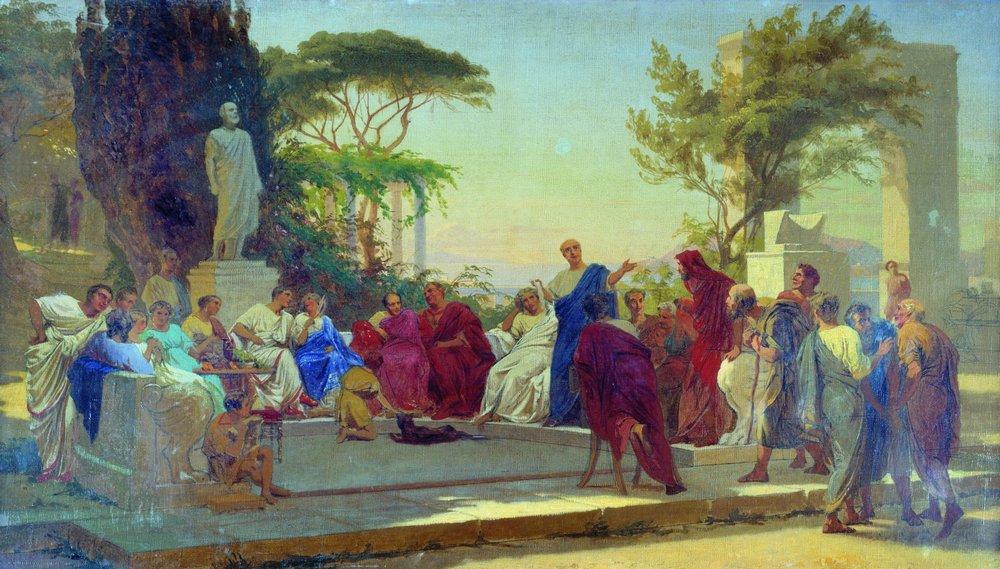|
Vatican Hill
Vatican Hill (; ; ) is a hill in Rome, located on the right bank (west side) of Tiber river, opposite to the traditional seven hills of Rome. The hill also gave the name to Vatican City. It is the location of St. Peter's Basilica. Etymology The ancient Romans had several opinions about the derivation of the Latin word ''Vaticanus''. Varro (1st century BC) connected it to a ''Deus Vaticanus'' or '' Vagitanus'', a Roman deity thought to endow infants with the capacity for speech evidenced by their first wail (''vagitus'', the first syllable of which is pronounced in Classical Latin). Varro's rather complicated explanation relates this function to the tutelary deity of the place and to the advanced powers of speech possessed by a prophet ('' vates''), as preserved by the later antiquarian Aulus Gellius: We have been told that the word ''Vatican'' is applied to the hill, and the deity who presides over it, from the ''vaticinia'', or prophecies, which took place there by the p ... [...More Info...] [...Related Items...] OR: [Wikipedia] [Google] [Baidu] |
Borgo (rione Of Rome)
Borgo (sometimes called also I Borghi) is the 14th (administrative district) of Rome, Italy. It is identified by the initials R. XIV and is included within Municipio I. Its coat of arms shows a lion (after the name " Leonine City", which was also given to the district), lying in front of three mounts and a star. These – together with a lion rampant – are also part of the coat of arms of Pope Sixtus V, who annexed Borgo as the 14th rione of Rome. History Roman Age: ''Ager Vaticanus'' During the Roman age, the Borgo district was part of the 14th Regio (Regio XIV Transtiberim) and was named '' Ager Vaticanus'', after the auguries (''vaticinii'') performed there by the Etruscan '' Augurs''. Since it lay outside the Pomerium (the religious city border inside which burial was forbidden) and was plagued by malaria, this territory was used as a burial place. Some tombs reached notable proportions, including the '' Terebinthus Neronis'', which was a round tomb surmounted by a ... [...More Info...] [...Related Items...] OR: [Wikipedia] [Google] [Baidu] |
Vates
In modern English, the nouns vates () and ovate (, ), are used as technical terms for ancient Celtic bards, prophets and philosophers. The terms correspond to a Proto-Celtic word which can be reconstructed as *''wātis''.Bernhard Maier, ''Dictionary of Celtic Religion and Culture'', trans. by Cyril Edwards (Woodbridge: Boydell, 1997), p. 278 .v. ''vates'' :wikt:vates">''vātēs'' (), "prophet, poet". This Latin noun was either a cognate of Celtic *''wātis'' (in which case the two words were descended from a common Italo-Celtic origin),Michiel de Vaan, ''Etymological Dictionary of Latin and the Other Italic Languages'', Leiden Indo-European Etymological Dictionary Series, 7 (Leiden: Brill, 2008), p. 656 [s.v. ''vātēs, -is'']. or else a loanword directly from Celtic. Despite being borrowed from the Latin form, the English word is generally used to refer to ancient Celtic seers rather than Roman ones. ''Ovate'' in English is a borrowing and adaptation of a Greek rendering of th ... [...More Info...] [...Related Items...] OR: [Wikipedia] [Google] [Baidu] |
Scholiast
Scholia (: scholium or scholion, from , "comment", "interpretation") are grammatical, critical, or explanatory comments – original or copied from prior commentaries – which are inserted in the margin of the manuscript of ancient authors, as glosses. One who writes scholia is a scholiast. The earliest attested use of the word dates to the 1st century BC. History Ancient scholia are important sources of information about many aspects of the ancient world, especially ancient literary history. The earliest scholia, usually anonymous, date to the 5th or 4th century BC (such as the ''scholia minora'' to the ''Iliad''). The practice of compiling scholia continued to late Byzantine times, outstanding examples being Archbishop Eustathius' massive commentaries to Homer in the 12th century and the ''scholia recentiora'' of Thomas Magister, Demetrius Triclinius and Manuel Moschopoulos in the 14th. Scholia were altered by successive copyists and owners of the manuscr ... [...More Info...] [...Related Items...] OR: [Wikipedia] [Google] [Baidu] |
Horace
Quintus Horatius Flaccus (; 8 December 65 BC – 27 November 8 BC), Suetonius, Life of Horace commonly known in the English-speaking world as Horace (), was the leading Roman lyric poet during the time of Augustus (also known as Octavian). The rhetorician Quintilian regarded his '' Odes'' as the only Latin lyrics worth reading: "He can be lofty sometimes, yet he is also full of charm and grace, versatile in his figures, and felicitously daring in his choice of words."Quintilian 10.1.96. The only other lyrical poet Quintilian thought comparable with Horace was the now obscure poet/metrical theorist, Caesius Bassus (R. Tarrant, ''Ancient Receptions of Horace'', 280) Horace also crafted elegant hexameter verses ('' Satires'' and '' Epistles'') and caustic iambic poetry ('' Epodes''). The hexameters are amusing yet serious works, friendly in tone, leading the ancient satirist Persius to comment: "as his friend laughs, Horace slyly puts his finger on his every fault; once let ... [...More Info...] [...Related Items...] OR: [Wikipedia] [Google] [Baidu] |
Janiculum
The Janiculum (; ), occasionally known as the Janiculan Hill, is a hill in western Rome, Italy. Although it is the second-tallest hill (the tallest being Monte Mario) in the contemporary city of Rome, the Janiculum does not figure among the proverbial Seven Hills of Rome, being west of the Tiber and outside the boundaries of the ancient city. Sights The Janiculum is one of the best locations in Rome for a scenic view of central Rome with its domes and bell towers. Other sights on the Janiculum include the church of San Pietro in Montorio, on what was formerly thought to be the site of St Peter's crucifixion; a small shrine known as the Tempietto, designed by Donato Bramante, marks the supposed site of Peter's death. The Janiculum also houses a Baroque fountain built by Pope Paul V in the late 17th century, the Fontana dell'Acqua Paola, and several foreign research institutions, including the American and Spanish Academies in Rome. The Hill is also the location of The ... [...More Info...] [...Related Items...] OR: [Wikipedia] [Google] [Baidu] |
Sextus Pompeius Festus
Sextus Pompeius Festus, usually known simply as Festus, was a Ancient Rome, Roman Grammarian (Greco-Roman), grammarian who probably flourished in the later 2nd century AD, perhaps at Narbo (Narbonne) in Gaul. Work He made a 20-volume epitome of Verrius Flaccus's voluminous and encyclopedic treatise ''De verborum significatione''. Flaccus had been a celebrated grammarian who flourished in the reign of Caesar Augustus, Augustus. Festus gives the etymology as well as the meaning of many words, and his work throws considerable light on the language, mythology and antiquities of ancient Rome. He made a few alterations, and inserted some critical remarks of his own. He also omitted such ancient Latin words as had long been obsolete; these he apparently discussed in a separate work now lost, entitled ''Priscorum verborum cum exemplis''. Even incomplete, Festus' lexicon reflects at second hand the enormous intellectual effort that had been made in the Augustan Age to put together informati ... [...More Info...] [...Related Items...] OR: [Wikipedia] [Google] [Baidu] |
Consular Fasti
In ancient Rome, the ''fasti'' (Latin plural) were chronological or calendar-based lists, or other diachronic records or plans of official and religiously sanctioned events. After Rome's decline, the word ''fasti'' continued to be used for similar records in Christian Europe and later Western culture. Public business, including the official business of the Roman state, had to be transacted on '' dies fasti'', "allowed days". The ''fasti'' were the records of this business. In addition to the word's general sense, there were ''fasti'' that recorded specific kinds of events, such as the ''fasti triumphales'', lists of triumphs celebrated by Roman generals. The divisions of time used in the ''fasti'' were based on the Roman calendar. The yearly records of the ''fasti'' encouraged the writing of history in the form of chronological ''annales'', "annals", which in turn influenced the development of Roman historiography. Etymology ''Fasti'' is the plural of the Latin adjective ''fas ... [...More Info...] [...Related Items...] OR: [Wikipedia] [Google] [Baidu] |
Etruscan Civilization
The Etruscan civilization ( ) was an ancient civilization created by the Etruscans, a people who inhabited Etruria in List of ancient peoples of Italy, ancient Italy, with a common language and culture, and formed a federation of city-states. After adjacent lands had been conquered its territory covered, at its greatest extent, roughly what is now Tuscany, western Umbria and northern Lazio, as well as what are now the Po Valley, Emilia-Romagna, south-eastern Lombardy, southern Veneto and western Campania. A large body of literature has flourished on the origins of the Etruscans, but the consensus among modern scholars is that the Etruscans were an indigenous population. The earliest evidence of a culture that is identifiably Etruscan dates from about 900 BC. This is the period of the Iron Age Villanovan culture, considered to be the earliest phase of Etruscan civilization, which itself developed from the previous late Bronze Age Proto-Villanovan culture in the same region, p ... [...More Info...] [...Related Items...] OR: [Wikipedia] [Google] [Baidu] |
De Civitate Dei
''On the City of God Against the Pagans'' (), often called ''The City of God'', is a book of Christian philosophy written in Latin by Augustine of Hippo in the early 5th century AD. Augustine wrote the book to refute allegations that Christianity initiated the decline of Rome and is considered one of his seminal works, standing alongside the '' Confessions'', the '' Enchiridion'', '' On Christian Doctrine'', and '' On the Trinity''. As a work of one of the most influential Church Fathers, ''The City of God'' is a cornerstone of Western thought, expounding on many questions of theology, such as the suffering of the righteous, the existence of evil, the conflict between free will and divine omniscience, and the doctrine of original sin. Background The sack of Rome by the Visigoths in 410 left Romans in a deep state of shock, and many Romans saw it as punishment for abandoning traditional Roman religion in favor of Christianity. In response to these accusations, and in order t ... [...More Info...] [...Related Items...] OR: [Wikipedia] [Google] [Baidu] |
Augustine Of Hippo
Augustine of Hippo ( , ; ; 13 November 354 – 28 August 430) was a theologian and philosopher of Berber origin and the bishop of Hippo Regius in Numidia, Roman North Africa. His writings deeply influenced the development of Western philosophy and Western Christianity, and he is viewed as one of the most important Church Fathers of the Latin Church in the Patristic Period. His many important works include '' The City of God'', '' On Christian Doctrine'', and '' Confessions''. According to his contemporary, Jerome of Stridon, Augustine "established anew the ancient Faith". In his youth he was drawn to the Manichaean faith, and later to the Hellenistic philosophy of Neoplatonism. After his conversion to Christianity and baptism in 386, Augustine developed his own approach to philosophy and theology, accommodating a variety of methods and perspectives. Believing the grace of Christ was indispensable to human freedom, he helped formulate the doctrine of original sin and m ... [...More Info...] [...Related Items...] OR: [Wikipedia] [Google] [Baidu] |
The City Of God
''On the City of God Against the Pagans'' (), often called ''The City of God'', is a book of Christian philosophy written in Latin by Augustine of Hippo in the early 5th century AD. Augustine wrote the book to refute allegations that Christianity initiated the decline of Rome and is considered one of his seminal works, standing alongside the '' Confessions'', the '' Enchiridion'', '' On Christian Doctrine'', and '' On the Trinity''. As a work of one of the most influential Church Fathers, ''The City of God'' is a cornerstone of Western thought, expounding on many questions of theology, such as the suffering of the righteous, the existence of evil, the conflict between free will and divine omniscience, and the doctrine of original sin. Background The sack of Rome by the Visigoths in 410 left Romans in a deep state of shock, and many Romans saw it as punishment for abandoning traditional Roman religion in favor of Christianity. In response to these accusations, and in order t ... [...More Info...] [...Related Items...] OR: [Wikipedia] [Google] [Baidu] |
Religion In Ancient Rome
Religion in ancient Rome consisted of varying imperial and provincial religious practices, which were followed both by the Roman people, people of Rome as well as those who were brought under its rule. The Romans thought of themselves as highly religious, and attributed their success as a world power to their collective piety () in maintaining Pax deorum, good relations with the gods. Their Polytheism, polytheistic religion is known for having honoured List of Roman deities, many deities. The presence of Magna Graecia, Greeks on the Italian peninsula from the beginning of the historical period influenced Culture of ancient Rome, Roman culture, introducing some religious practices that became fundamental, such as the of Apollo. The Romans looked for common ground between their major gods and those of the Greeks (), adapting Greek mythology, Greek myths and iconography for Latin literature and Roman art, as the Etruscans had. Etruscan religion was also a major influence, partic ... [...More Info...] [...Related Items...] OR: [Wikipedia] [Google] [Baidu] |





